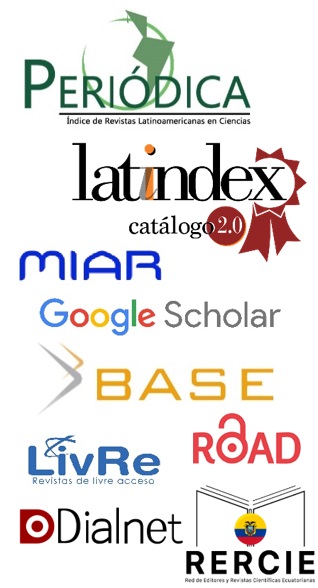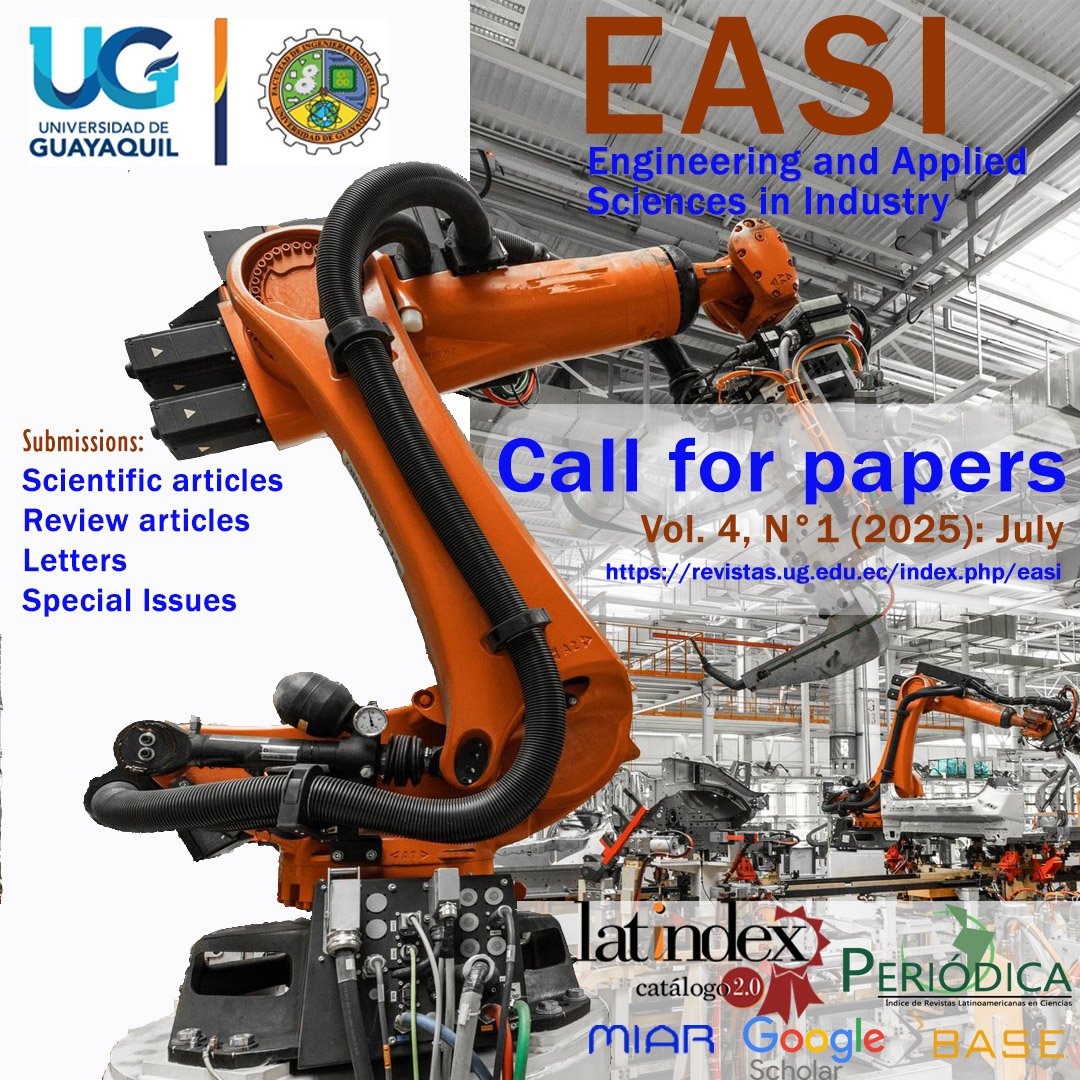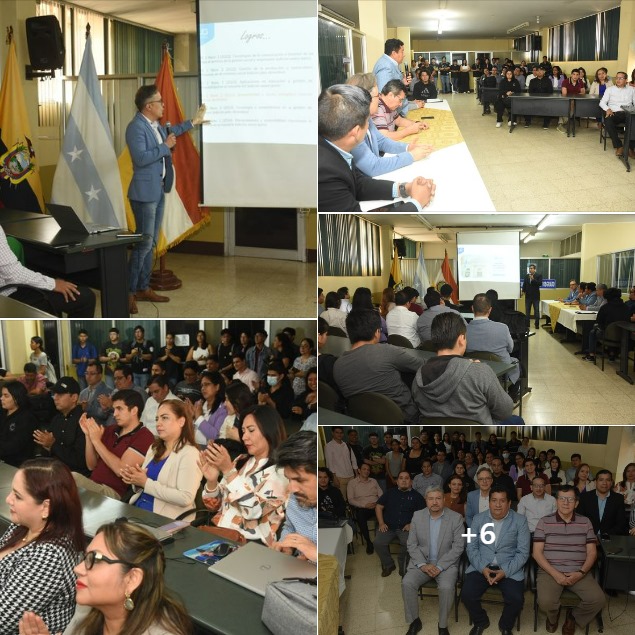Análisis gráfico descriptivo de la pandemia Covid-19 en Ecuador
DOI:
https://doi.org/10.53591/easi.v1i1.1768Palabras clave:
COVID-19, Pandemia, Virus, Software, Base de DatosResumen
El presente documento muestra el informe acerca de la propagación del virus COVID-19 en Ecuador, durante los meses más críticos de la pandemia. El análisis se realizó aplicando técnicas de estadística descriptiva a través de gráficos generados en software libre RStudio. El estudio estadístico aplicó una base de datos que muestra los registros diarios de contagios y defunciones por provincia, durante 187 días. Los tipos de gráficos empleados como diagramas de barras y dispersión dinámicos se encuentran en función de los distintos días de estudio. Además, un mapa geográfico de todo el país, donde se aprecia el nivel de afectación en cada zona. De esta manera se pudo evidenciar que las provincias más afectadas eran Guayas y Pichincha, mismas que son consideradas las más pobladas del Ecuador.
Citas
Afzal, M., Li, J., Amin, W., Huang, Q., Umer, K., Ahmad, S. A., Ahmad, F., & Raza, A. (2022). Role of blockchain technology in transactive energy market: A review. Sustainable Energy Technologies and Assessments, 53, 102646. https://doi.org/10.1016/j.seta.2022.102646
Alvi, S. T., Uddin, M. N., Islam, L., & Ahamed, S. (2022). DVTChain: A blockchain-based decentralized mechanism to ensure the security of digital voting system voting system. Journal of King Saud University - Computer and Information Sciences. https://doi.org/10.1016/j.jksuci.2022.06.014
Broday, D. M., Arpaci, A., Bartonova, A., Castell-Balaguer, N., Cole-Hunter, T., Dauge, F. R., Fishbain, B., Jones, R. L., Galea, K., Jovasevic-Stojanovic, M., Kocman, D., Martinez-Iñiguez, T., Nieuwenhuijsen, M., Robinson, J., Svecova, V., & Thai, P. (2017). Wireless distributed environmental sensor networks for air pollution measurement-the promise and the current reality. Sensors (Switzerland), 17(10). https://doi.org/10.3390/s17102263
Budi, S., Susanto, F., de Souza, P., Timms, G., Malhotra, V., & Turner, P. (2018). In search for a robust design of environmental sensor networks. Environmental Technology (United Kingdom), 39(6). https://doi.org/10.1080/09593330.2017.1310303
Chan, K., Schillereff, D. N., Baas, A. C. W., Chadwick, M. A., Main, B., Mulligan, M., O’Shea, F. T., Pearce, R., Smith, T. E. L., van Soesbergen, A., Tebbs, E., & Thompson, J. (2021). Low-cost electronic sensors for environmental research: Pitfalls and opportunities. Progress in Physical Geography, 45(3). https://doi.org/10.1177/0309133320956567
Dhall, S., Mehta, B. R., Tyagi, A. K., & Sood, K. (2021). A review on environmental gas sensors: Materials and technologies. In Sensors International (Vol. 2). https://doi.org/10.1016/j.sintl.2021.100116
Guo, H., & Yu, X. (2022). A survey on blockchain technology and its security. Blockchain: Research and Applications, 3(2). https://doi.org/10.1016/j.bcra.2022.100067
Han, Q., Liu, P., Zhang, H., & Cai, Z. (2019). A Wireless Sensor Network for Monitoring Environmental Quality in the Manufacturing Industry. IEEE Access, 7. https://doi.org/10.1109/ACCESS.2019.2920838
Handayani, A. S., Husni, N. L., Nurmaini, S., & Permatasari, R. (2020). Environmental Application with Multi Sensor Network. Computer Engineering and Applications, 9(1).
Jumaah, H. J., Kalantar, B., Mansor, S., Halin, A. A., Ueda, N., & Jumaah, S. J. (2021). Development of UAV-based PM2.5 monitoring system. Drones, 5(3). https://doi.org/10.3390/drones5030060
Khan, K. M., Arshad, J., & Khan, M. M. (2020). Simulation of transaction malleability attack for blockchain-based e-Voting. Computers and Electrical Engineering, 83. https://doi.org/10.1016/j.compeleceng.2020.106583
Liao, Z., & Cheng, S. (2023). RVC: A reputation and voting based blockchain consensus mechanism for edge computing-enabled IoT systems. Journal of Network and Computer Applications, 209, 103510. https://doi.org/10.1016/J.JNCA.2022.103510
Liu, Y., & Xu, G. (2021). Fixed degree of decentralization DPoS consensus mechanism in blockchain based on adjacency vote and the average fuzziness of vague value. Computer Networks, 199. https://doi.org/10.1016/j.comnet.2021.108432
Mao, F., Khamis, K., Krause, S., Clark, J., & Hannah, D. M. (2019). Low-Cost Environmental Sensor Networks: Recent Advances and Future Directions. In Frontiers in Earth Science (Vol. 7). https://doi.org/10.3389/feart.2019.00221
Merlo, V., Pio, G., Giusto, F., & Bilancia, M. (2022). On the exploitation of the blockchain technology in the healthcare sector: A systematic review. Expert Systems with Applications, 118897. https://doi.org/10.1016/j.eswa.2022.118897
Mookherji, S., Vanga, O., & Prasath, R. (2022). Blockchain-based e-voting protocols. Blockchain Technology for Emerging Applications: A Comprehensive Approach, 239–266. https://doi.org/10.1016/B978-0-323-90193-2.00006-5
Ooi, V., Kian Peng, S., & Soh, J. (2022). Blockchain land transfers: Technology, promises, and perils. Computer Law and Security Review, 45. https://doi.org/10.1016/j.clsr.2022.105672
Panja, S., & Roy, B. (2021). A secure end-to-end verifiable e-voting system using blockchain and cloud server. Journal of Information Security and Applications, 59. https://doi.org/10.1016/j.jisa.2021.102815
Perez, A. O., Bierer, B., Scholz, L., Wöllenstein, J., & Palzer, S. (2018). A wireless gas sensor network to monitor indoor environmental quality in schools. Sensors (Switzerland), 18(12). https://doi.org/10.3390/s18124345
Qutieshat, A., Aouididi, R., & Arfaoui, R. (2019). Design and Construction of a Low-Cost Arduino-Based pH Sensor for the Visually Impaired Using Universal pH Paper. Journal of Chemical Education, 96(10). https://doi.org/10.1021/acs.jchemed.9b00450
Rahman, M. S., Chamikara, M. A. P., Khalil, I., & Bouras, A. (2022). Blockchain-of-blockchains: An interoperable blockchain platform for ensuring IoT data integrity in smart city. Journal of Industrial Information Integration, 30, 100408. https://doi.org/10.1016/J.JII.2022.100408
Rajasekaran, A. S., Azees, M., & Al-Turjman, F. (2022). A comprehensive survey on blockchain technology. Sustainable Energy Technologies and Assessments, 52. https://doi.org/10.1016/j.seta.2022.102039
Verma, M. (2017a). International journal of engineering sciences & research technology working, operation and types of arduino microcontroller. International Journal of Engineering Sciences & Research Technology Working, 6(6).
Verma, M. (2017b). Working, Operation and Types of Arduino Microcontroller. © International Journal of Engineering Sciences & Research Technology, 6(6).
Xu, Y., Tao, X., Das, M., Kwok, H. H. L., Liu, H., Wang, G., & Cheng, J. C. P. (2023). Suitability analysis of consensus protocols for blockchain-based applications in the construction industry. Automation in Construction, 145, 104638. https://doi.org/10.1016/J.AUTCON.2022.104638
Yang, X., Yi, X., Nepal, S., Kelarev, A., & Han, F. (2020). Blockchain voting: Publicly verifiable online voting protocol without trusted tallying authorities. Future Generation Computer Systems, 112, 859–874. https://doi.org/10.1016/j.future.2020.06.051
Yu, F., Lin, H., Wang, X., Yassine, A., & Hossain, M. S. (2022). Blockchain-empowered secure federated learning system: Architecture and applications. Computer Communications. https://doi.org/10.1016/j.comcom.2022.09.008
Zheng, K., Zheng, L. J., Gauthier, J., Zhou, L., Xu, Y., Behl, A., & Zhang, J. Z. (2022). Blockchain technology for enterprise credit information sharing in supply chain finance. Journal of Innovation and Knowledge, 7(4). https://doi.org/10.1016/j.jik.2022.100256
Publicado
Cómo citar
Número
Sección
Licencia
Derechos de autor 2022 Jeison Ávila Lucas, Luis Pilacuan Bonete, Karina Valenzuela Burbano

Esta obra está bajo una licencia internacional Creative Commons Atribución-NoComercial-SinDerivadas 4.0.
Las contribuciones publicadas en la revista EASI se rigen por la licencia de acceso abierto CC BY-NC-ND 4.0 (Creative Commons Reconocimiento-NoComercial-SinDerivadas 4.0). Esta licencia te empodera como autor, y garantiza la amplia difusión de tu investigación mientras protege tus derechos.
Para autores:
- Los autores pueden reproducir y distribuir la obra en cualquier formato no comercial, siempre que la obra indique los autores y datos de la revista EASI, y no contravenga los puntos mencionados en el apartado de los permisos y prácticas editoriales.
- La revista obtiene una licencia para publicar y distribuir el manuscrito original.
Para lectores/usuarios:
Acceso y distribución gratuita: cualquier lector o usuario puede acceder, descargar, copiar, imprimir y compartir el artículo publicado libremente según los términos de la licencia CC BY-NC-ND 4.0.
Reconocimiento obligatorio: si un tercero utiliza el material publicado, debe dar crédito al creador proporcionando el nombre, el título del artículo y el nombre de la revista, lo que garantiza la propiedad intelectual del autor(es) y ayuda a construir su reputación académica.
Uso no comercial: solo se permite el uso no comercial del trabajo publicado. No comercial significa que no está destinado principalmente ni dirigido al aprovechamiento comercial o la compensación monetaria por parte de ningún tercero.
No se permiten modificaciones: el contenido del artículo publicado no se puede cambiar, mezclar o reconstruir a partir del trabajo del autor. Esto asegura la integridad y precisión de los resultados de la investigación.




